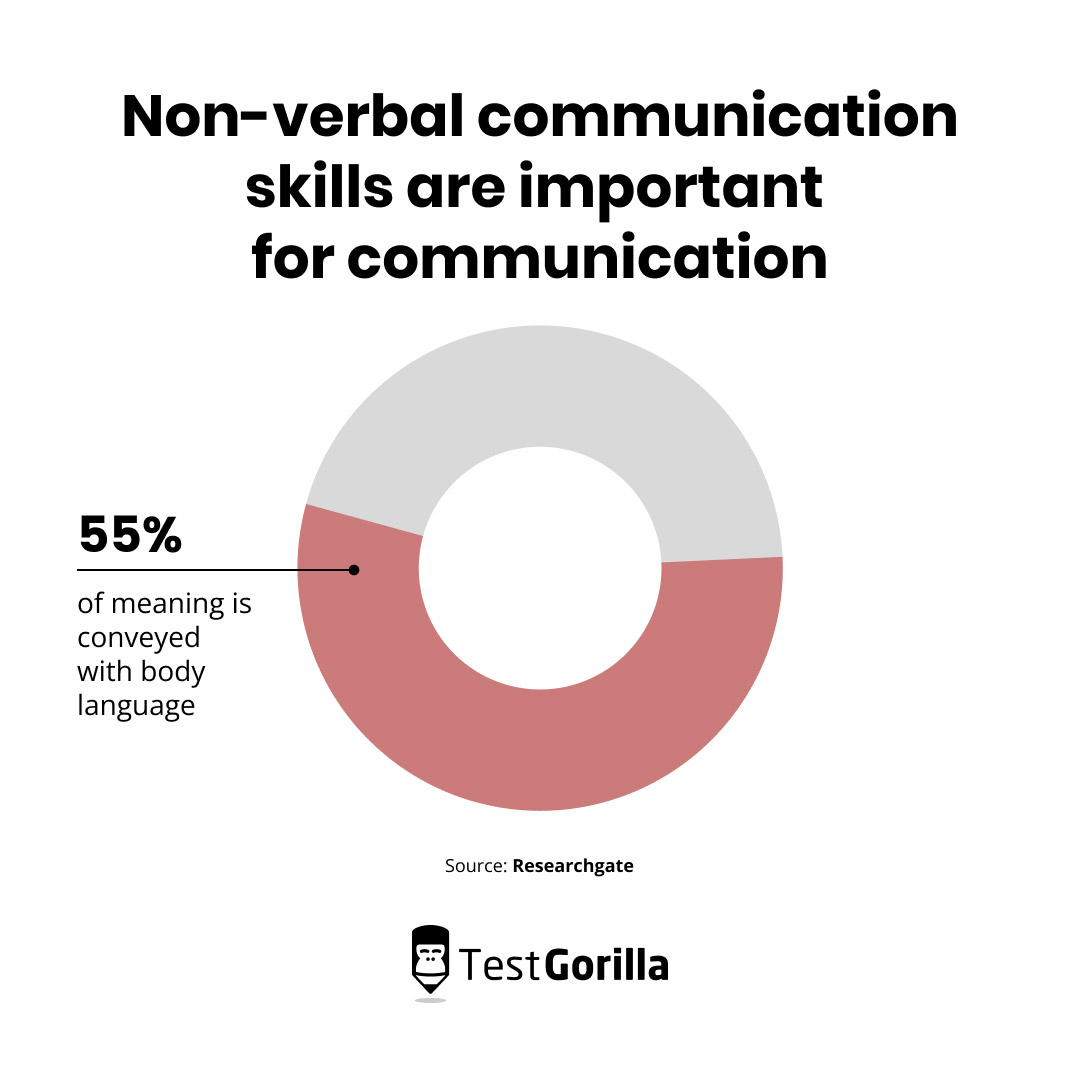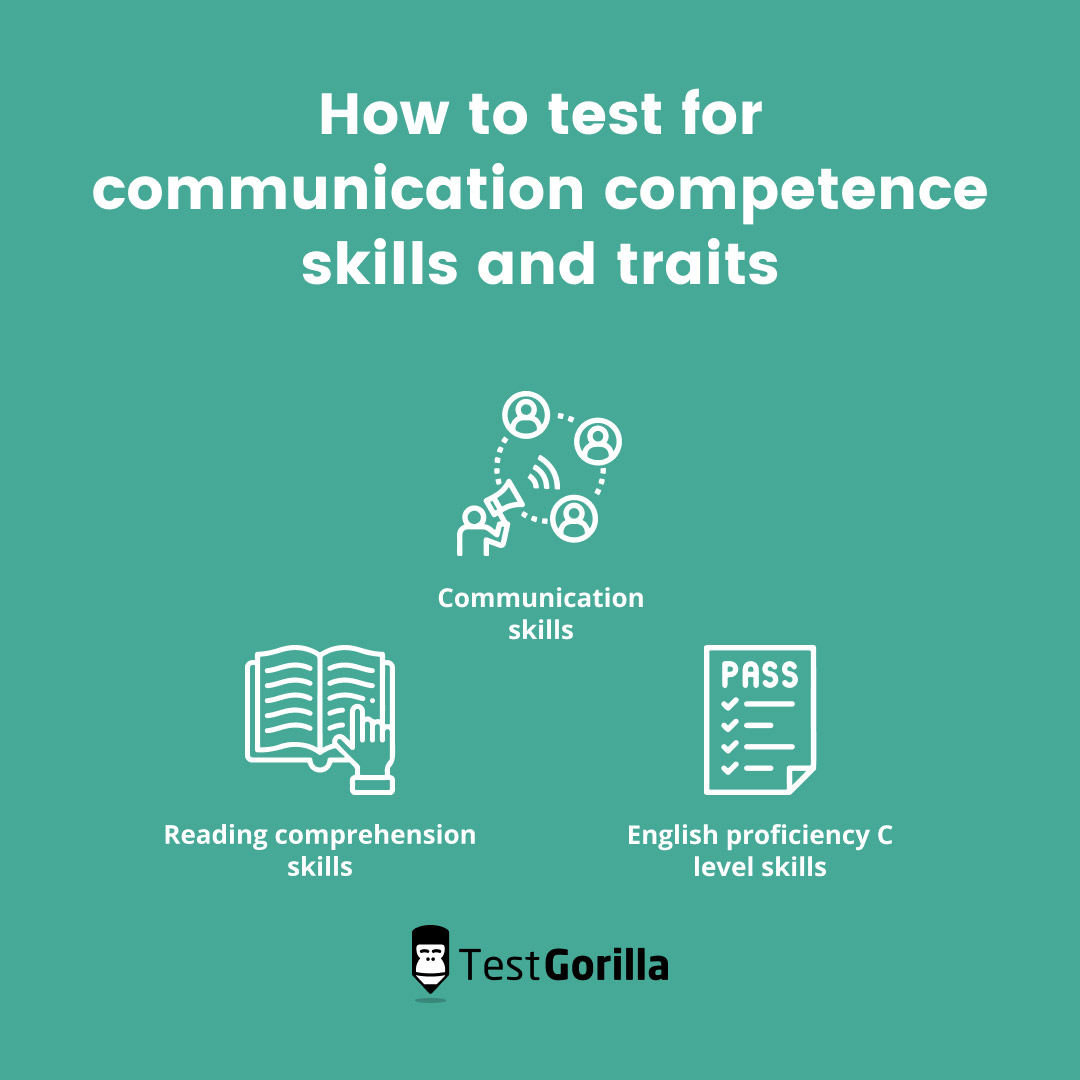Communication is a critical and ubiquitous skill in the workplace, crucial for employees who send instant messages and emails, create written documents, use video conferencing software, or need to train or manage other team members. Having strong communication skills reduces errors and ambiguity across virtually all roles.
Although verbal and written skills can undoubtedly enhance any new hire’s performance, many hiring managers rely on resumes as evidence supporting these abilities. This assessment method makes finding skilled communicators difficult due to its lack of objectivity.
Using tests like our Communication skills test as part of a broader candidate assessment is a more effective strategy to ensure you’re hiring those with the appropriate skill set for your role.
In this article, we’ll look at the best ways to assess communication competence and the most insightful tests to use in your hiring process.
Table of contents
- What is a communication competence skills assessment?
- Why are communication competence skills important?
- Which skills and traits are important for communication?
- Communication competence skills and traits tests
- Communication competence skills assessment FAQs
- How TestGorilla can help you find candidates with communication skills
- How to use TestGorilla in your hiring process
- Assess candidate communication skills with TestGorilla
What is a communication competence skills assessment?
A communication competence assessment is a collection of communication skills tests. Together, these tests create a broader assessment tool that helps you review the skills you’re looking for in ideal candidates, which may include the abilities to:
Understand written information
Interpret cues and listen actively
Clarify next steps
Communicate using professional etiquette
In simple terms, the assessment measures how well candidates can express and understand complex ideas verbally and in writing.
Your company should focus on hiring candidates who don’t miscommunicate when completing their specific duties because this can ultimately make a better impression on your stakeholders and improve your business outcomes.
So, as you assess communication skills, you should also consider customizing your assessment to match the specific role you’re hiring for.
For example, pair an Administrative Assistant test with a Communication skills test to determine how well prospective administrative assistants communicate. Or, for a customer service role, you could combine our Customer Service test with a Reading comprehension test.
Video-style custom questions are another common feature of communication assessments, helping you learn how candidates communicate verbally. This assessment feature requires candidates to record their responses to your chosen question. You can review their reply, check how clearly they express their ideas, and determine if their communication competence matches your preferences.
Why are communication competence skills important?
Communication is a cornerstone of collaboration in the workplace, but it also has many other benefits. To ensure your new hire works well with your team, they must be excellent communicators.
Let’s consider some additional reasons why communication skills are crucial:
1. Written and spoken communication makes presentations easier
Excellent written and spoken communication skills help employees prepare and deliver high-quality presentations.
For instance, a marketing team leader may use written communication skills to write concise bullet-point notes for a presentation on content writing best practices. They can then deliver the presentation and answer any questions from their team by using their verbal communication skills.
These skills ensure the team leader delivers the information clearly and succinctly but with the right level of detail. They also ensure all team members understand the best ways to write high-quality articles. The positive effects of this example are increased client satisfaction and a better relationship between them and the company.
2. Active listening skills help with conflict resolution
Active listening is a crucial skill for conflict resolution. It helps employees understand and clarify points of disagreement during work-related conflicts.
For example, a software developer might use active listening skills to understand and clarify disagreements with a software tester about their code. They may use paraphrasing skills and verbal affirmations to confirm they understand the tester’s concerns.
This skill makes it easy for software developers to receive feedback and implement changes to their software. The positive implications of this outcome may be better software that meets the end user’s requirements.
3. Communication etiquette enhances the company’s reputation
An employee’s skills in using communication etiquette help a company improve its reputation with clients or customers by ensuring messages are always conveyed professionally.
For instance, a legal assistant might use communication etiquette skills to liaise between an attorney, client, and their legal firm. They may use skills in modifying their tone and using the correct mode of address when they give clients information about a case.
This skill makes it easy for legal firms to build trust with their clients thanks to their excellent reputation. The positive effects of this skill include satisfied clients who know they have entrusted their case to the right firm.
Which skills and traits are important for communication?
If you’ve never had to evaluate communication types or skills, you may be unclear about the specific skills you should seek. In this case, consider the following abilities and traits when assessing candidates’ communication skills:
Non-verbal communication skills
Non-verbal communication includes skills in understanding and using non-verbal cues. Specifically, this skill set involves reading body language, facial expressions, and gestures. It’s essential because body language accounts for 55% of conveyed meaning.
Employees might use non-verbal communication skills in team meetings via video conferencing software. If they’re a team leader, they may note a team member’s facial expressions to determine if they understand the points raised in the meeting. They may achieve the same goal by checking if that team member is making eye contact with them.
1. Reading comprehension skills
Reading comprehension skills include understanding the written word and interpreting different contexts.
For example, new hires will use reading comprehension skills when studying documents about career progression. They may first read and process the words in the documents and then infer their meaning and actions based on what they’ve read.
2. Feedback skills
Feedback skills include using specific examples to give feedback, provide suggestions, and instruct how to implement them.
Team members in senior roles will use skills in giving feedback when offering progression tips to junior team members. For instance, senior teachers may suggest specific examples of ways to improve a lesson plan and make lessons more engaging. This skill helps ensure junior teachers succeed in keeping their students focused.
3. Skills in communicating with clarity
Communicating with clarity includes summarizing information, such as being concise when communicating verbally and in writing. This skill set may also include taking complex communication styles and concepts and simplifying them for a broader audience.
For example, academic researchers use these skills when writing an introduction or conclusion to an article. They can summarize information related to the topic and use concise sentence structures to convey the core issues without confusing the reader. This skill makes academic articles easier to understand.
Communication competence skills and traits tests
You will find it easier to hire excellent communicators when you implement pre-employment screening tests in your hiring process. TestGorilla assessments can include up to five skills tests. Your job is to choose the mix of tests that best target the skills you’re looking for in candidates. Read on for our top recommendations of communication skills tests you can use to assess candidates objectively.
1. Communication skills test
Our Communication test helps you identify which candidates can communicate clearly and to the highest standard. It assesses if candidates can:
Understand the written word
Clarify messages and summarize them
Notice and understand non-verbal cues
Write and speak using professional etiquette
Use active listening
The results will tell you which candidates can use communication skills in various scenarios, such as providing feedback to other employees.
2. Reading comprehension skills test
Our Reading Comprehension test helps you assess how well candidates comprehend portions of text. It evaluates if candidates can:
Identify the core thought of a passage
Infer meaning from a passage
Make connections between core ideas and the general context
Test results will reveal whether candidates can understand written communications from team members. They’ll also indicate which candidates have excellent analytical skills.
3. English proficiency C2 level skills test
The English proficiency C2 level test helps you evaluate your candidate’s English proficiency in four areas. It assesses how well candidates can:
Use English grammar and vocabulary
Compose sentences in English
Comprehend texts written in English
Comprehend the English spoken word
The results will show you which candidates have mastered the English language and can communicate fluently in English. They’ll also reveal which candidates can collaborate with coworkers when interacting in English.
Communication competence skills assessment FAQs
Looking for more information about communication assessments and how they work? Here are some common questions and answers you might be looking for:
What questions should I ask to check a candidate’s communication skills?
In a communication assessment, you can ask custom questions about situations requiring verbal, written, and active listening skills. Here are a few examples:
Tell me about a time you showed excellent verbal communication skills.
How do you write error-free emails?
How do you use active listening to build strong relationships with colleagues?
How do you test communication?
The easiest way to test communication is to evaluate competence with a skills assessment. Ask candidates to complete your assessment and review their results. You can then invite your candidates to an in-person or video interview, which is a great way to further test their spoken communication and active listening skills.
What makes an effective communication competence assessment?
An effective communication competence assessment involves multiple tests that measure all critical components of excellent communication. It also contains specific features, such as anti-cheating and mobile compatibility. These features make taking the tests a seamless experience for candidates.
How TestGorilla can help you find candidates with communication skills
Regardless of the role you’re hiring for, ensuring your candidates have the right communication skills to perform well in your company is essential. Keep reading to learn why TestGorilla supports your hiring efforts and helps you build a shortlist of the best communicators.
Tests endorsed by studies, frameworks, and experts
Our tests are endorsed by studies and created by experts. For example, the English proficiency C2 level skills test aligns with the Central European Framework for Languages (CEFR), and subject matter experts with more than 25 years of experience created it. With expert insights, you can rely on our tests to provide reliable results.
Contributes to faster hiring decisions
TestGorilla will help you make faster hiring decisions. You’ll find skilled communicators quickly because you won’t have to screen all the resumes you receive. You also won’t have to hesitate when building a shortlist because the highest-performing candidates will appear at the top of the assessment results. You’ll automatically know who to invite to an interview.
Removes subjective candidate evaluation processes
Our assessments remove a subjective candidate evaluation process and ensure you focus on the numbers when hiring. You won’t have to rely on your candidates’ self-review regarding their communication skills. By using our recommended tests and custom questions, you’ll instead have statistical and visual proof of candidates’ communication abilities.
How to use TestGorilla in your hiring process
It’s easy to use TestGorilla in your hiring process. Complete the following three steps to use our data-driven hiring tools and find great communicators to grow your company.
1. Create a communication competence assessment
After you sign up for TestGorilla and name your new assessment, select up to five relevant tests from our test library and add up to 20 custom questions. If you need additional inspiration, refer to our library of custom questions.
2. Choose your invitation method
Once you’ve built your communication competence assessment, choose the invitation method that’s ideal for you and ask candidates from your pool to complete it. You can distribute the assessment through email invitations, your applicant tracking system, or the TestGorilla platform.
3. Explore the reports to choose a candidate
You’ll receive real-time results for all the tests your candidates complete. You can then explore their results and see which candidate is the most competent communicator. You should also review your custom question responses to check your candidates more thoroughly.
Assess candidate communication skills with TestGorilla
Pre-employment testing helps you quickly and efficiently assess whether your candidates’ communication skills match your expectations.
If you’re looking to gauge your candidates’ ability to communicate effectively within your company, try using a skills assessment for a fair and unbiased approach.
Create your free TestGorilla account and ask our experts for a demo to learn how our platform makes hiring easier. Choose TestGorilla and hire without uncertainty.
Related posts
Hire the best candidates with TestGorilla
Create pre-employment assessments in minutes to screen candidates, save time, and hire the best talent.
Latest posts
The best advice in pre-employment testing, in your inbox.
No spam. Unsubscribe at any time.

Hire the best. No bias. No stress.
Our screening tests identify the best candidates and make your hiring decisions faster, easier, and bias-free.
Free resources
This checklist covers key features you should look for when choosing a skills testing platform
This resource will help you develop an onboarding checklist for new hires.
How to assess your candidates' attention to detail.
Learn how to get human resources certified through HRCI or SHRM.
Learn how you can improve the level of talent at your company.
Learn how CapitalT reduced hiring bias with online skills assessments.
Learn how to make the resume process more efficient and more effective.
Improve your hiring strategy with these 7 critical recruitment metrics.
Learn how Sukhi decreased time spent reviewing resumes by 83%!
Hire more efficiently with these hacks that 99% of recruiters aren't using.
Make a business case for diversity and inclusion initiatives with this data.





















